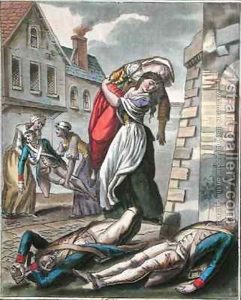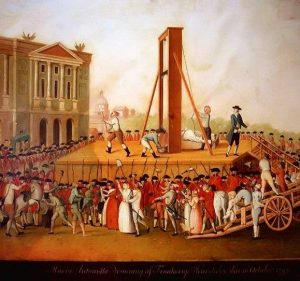Below is a detailed article based on the French Revolution, also known as ‘Revolution of 1789’ that started in 1787 and lasted until 1799. It was a period of absolute destruction of the social and political lives of the people of France. It was the most violent and universally significant revolution.
What were the Causes of the French Revolution?

The social structure in France was one of the basic causes of the French Revolution. The Feudal system had cause high discomfort in the lives of common people, such as the peasants and the labourers. The other class, that is the higher class that included the nobles and the merchants, manufacturers and professionals exploited the lower class with their power of wealth. They rose to political power in the medieval age.
This feudalism came to be suppressed in the early 17th century. Peasants began to improve the standard of living and educated their children. They were now looking to take over complete ownership of their lands from the Feudal Lords. However, this increased population in the country and other parts of Europe and it nearly doubled from 1789 to 1800. France was now the most powerful country in Europe.

There was an increase in the demand for food and shelter since the country had become overpopulated. At this time, trade conditions for European traders became favourable and they became more and more wealthy because of the Brazilian gold mine in the 17th century. Due to this, the prices of goods and services rose to such a level that common people could not afford them anymore. This caused a number of revolts starting from 1789 onwards.
The increase in poor economic conditions came to arise and was recognised by the European rulers. They then asked the nobles and the members of the clergy to pay taxes. however, the clergy and the nobles were always exempt from paying taxes and therefore, refused to do so. They caused dispute and revolted separately against the monarchy.
Aristocratic Revolt in the French Revolution
Charles – Alexandre de Calonne was a French official and the controller of general finances. He witnessed the depleting economy of France and decided to take action. he called an assembly of high ranking clergymen, great nobles and the representatives of the bourgeoisie. in February 1787 to explain to them the conditions of the economy of France and demand them to pay taxes.

But even after this, the high priests and the nobles refused to take responsibility for the depleting economic conditions. They called another assembly of the Estates General, that is the representatives of the High Priests and the Aristocrats, representatives of the Nobles. However, the officials that ran the country knew how tough t was to do so and kept insisting on Tax to be paid by the upper class.
These were the followers and successors of Charles – Alexandre de Calonne. Their revolt against the upper class is called the Aristocratic Revolt.
The Reign of Terror – The First Phase
After the many revolts in 1789, the French revolution acted as a hope to those countries that were also seeking justice like Belgium, Austria and the German States. Many missionaries and revolutionaries, along with high clergy members – the Ecclesiastes moved away from France due to the frightening situations and hence, abandoned their own country.
Finally, due to all the revolts by common men and the Estates General, the National Constituent Assembly proclaimed a principle. It was the proclamation of the right to self-determination. This gave rise to the territory of Avignon to be united with France in September 1791. Together with these forces, France declared war against Austria in 1792.
France was defeated in the first phase. Later, Prussia joined in with the Austrian Empire and marched towards Paris putting their forces together. The Queen of France – Marie Antoinette privately made her own brother – Leopold II invade France. Just when the subjects of the kingdom became aware of this corruption, they rose to revolt. They broke out into the prison where the clergies and nobles were hidden and butchered all of them.
The National Convention met on this day and awakened in the people, the sense of French Nationalism. The very next day, the monarchy was abolished and France became a republican nation.
The Reign of Terror – The Second Phase
In the second phase, the French revolutionaries occupied Belgium, Rhineland and Savoy. During the same time in France, the National Convention was being divided into groups of those in favour of the bourgeois republic and those in favour of the Montagnards (Mountain Men) who demanded more economic and political power to be given to the lower class.
The National Convention consisted of a majority of Montagnards. Therefore, a judgement was passed by them for the execution of Louis XVI on 21st of January 1793 and later the execution of Marie Antoinette.

The Reign of Terror – The Third Phase
In the third phase of the war, the Austrian, Prussian along with the British formed a group against the French Terror. They were now strong enough to defeat France. France was defeated by Austria and Belgium. They further, invaded and threatened Paris. Meanwhile, the National Convention became powerful and was dominated by the Montagnards. They were highly supported by the craftsmen, peasants and shopkeepers.
They now became responsible for favouring the defence of the country. They introduced a radicle approach to social and economic policies. They favoured the poor and restricted the sale of property of emigres. These measures provoked a violent reaction from the higher classes and led to the Wars of Vendee. There was chaos and the government raised an army of over 1 million battalions.
The Reign of Terror – The Fourth Phase
In the fourth phase, the French defeated the Austrian armies and captured Austria. They also captured Belgium and became powerful again. The National Convention was now weakened because a French Lawyer – Maximilien Robespierre who was a great influencer during the Reign of Terror was thrown out of the Convention and then executed.

Slowly, the National Convention came was broken down and a new young General Napoleon Bonaparte crushed the Royalists of the Society and gained power. This is when the French Revolution finally ended in the year 1799.